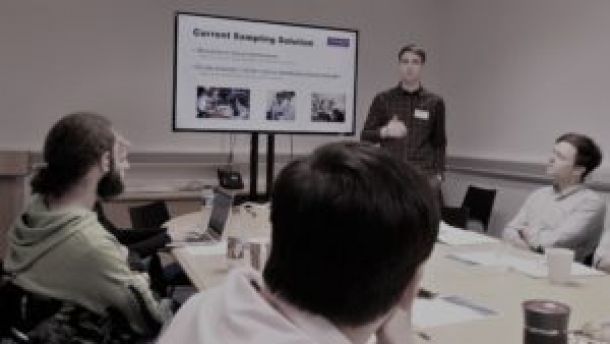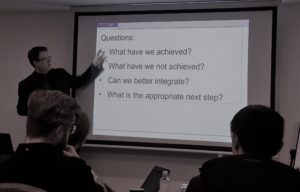HRI – Human Robot Interaction – is one of five key research themes within the RAIN Hub. This subject connects human beings with the mechanised tools that could allow us to work more safely and efficiently. The importance of HRI comes down to a simple concept; the kit can be as fancy as you like but it needs to be easy to use otherwise people won’t want to use it. As one of our underlying research themes, HRI underpins all of the research that is done as part of the three working groups. However, it has not been such a visible focus of our work as the Remote Handling, Remote Inspection and Safety Case challenge areas. External review of RAIN’s progress highlighted this as something to improve; so here we outline some of the recent work in HRI.
Every other month we get together for “theme meetings”. These focus on each of the research themes, and give everyone a chance to present, discuss, and get feedback on their latest research. At the November 2019 session we had guest appearances from Bristol Robotics Laboratory (BRL), a team which is part of the NCNR Hub. They have similar interest in HRI, and provided valuable insight. A follow up HRI-specific event was organised to delve deeper into specifics and include more people from across, and outside of, the hubs.

The follow up event was hosted by BRL in December 2019. The session included talks by Andy West – discussing the TORONE project, Emily Collins – from RAIN presenting the Challenges of HRI, and an overview of Bristol Robotics HRI interests and progress by Alex Smith. The audience included members of RAIN, NCNR and HRI specialists outside of either Hub. Many thanks to Emily Collins and Alex Smith for setting up this collaborative HRI meeting. The session was a great success, and important for three key reasons. Firstly, sharing progress allows researchers to identify opportunities for collaboration, to enhance progress, and reduce duplication of work. Secondly, it identified shared needs. There was a consensus that more access to real user testing is needed, i.e. getting real glovebox / teleoperators to use and offer feedback on research kit. This forms the basis of user-centred design, and can offer huge improvements. Thirdly, meets such as this build trust and networks amongst researchers. Trust is essential in such circumstances, and person-to-person engagements really helps to foster that spirit.

The next RAIN Theme meeting was held in February 2020. Guido Herrmann headed the HRI session and again we welcomed researchers from BRL. Mechanisms to gather and make use of real operator feedback were the primary discussion points. This feedback is hugely valuable to influence the research work that is being done. However, gathering and making use of this feedback is a challenging task that needs in depth planning. The validity of the data has to be considered from a research perspective, but also setting the scene appropriately so that operators’ time is used most appropriately, and they are supportive of what we’re trying to achieve. Longer articles have been written on the subject of user engagement, but suffice to say it can be easy to create the wrong impression when presenting new technology to address ‘old’ problems. We also recognise that the ‘wants and needs’ vary depending on whether the viewer is in a management or operational role.
RAIN is very keen to create a nuclear environment where deployment of robotics is the norm, and recognise that operators are at the centre of that. Focusing on HRI, while harnessing the benefits of collaboration, will be a valuable endeavour.